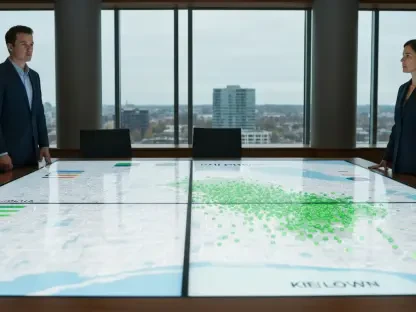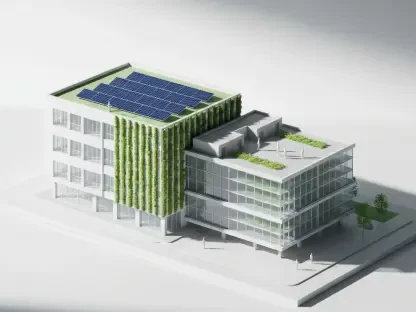The Malaysian construction sector is experiencing significant growth in early 2025, marked by an unexpected surge in residential construction activities despite a decline in overall property transactions. This development has captured the attention of market analysts, given the 6.2% drop in transaction numbers and a notable 8.9% decrease in transaction value to RM51.42 billion compared to the same period last year. These figures reflect a challenging environment where homebuyers exhibit caution, yet they contrast sharply with the sector’s vigorous construction activity. A 30.2% increase in housing completions, totaling 9,329 units, and a 32.5% rise in new construction starts underscore a dynamic yet paradoxical market scenario. This activity suggests that while investors may be hesitant to purchase finished properties, there is robust confidence in new developments, potentially aimed at future demand and economic recovery. However, the reduction in planned new developments indicates a cautious approach by developers, balancing optimism against market realities.
Government Initiatives and Economic Zones
Key government initiatives have played a crucial role in the sustenance and resilience of Malaysia’s construction sector during this period. The Director-General Abdul Razak Yusak pointed out that the initial sluggishness in property transactions was counterbalanced by a sharp increase in construction and residential launches. The state’s financial interventions, such as the Program Residensi Rakyat and Projek Rumah Mesra Rakyat, have provided indispensable backing for these activities, offering affordable housing options and encouraging developers to engage in new projects. The economic boost from broad-scale infrastructure and special economic zones, like the Forest City Special Financial Zone and the Johor–Singapore Special Economic Zone, has further invigorated the industry. These developments extend beyond residential projects, encompassing commercial and industrial domains, promising long-term economic benefits. They also create direct and indirect job opportunities, uplifting the construction sector’s vibrancy and Malaysia’s economic milieu.
The rise in the commercial retail sector occupancy complements the housing trends, indicating an overall positive tilt in the market environment. Shopping complexes have improved with occupancy reaching 79%, suggesting recovering consumer confidence. The interplay of government measures and economic zones has created a nurturing environment for growth, yielding positive results reflected in market statistics. Despite uncertainties, these strategic actions ensure a controlled yet progressive development trajectory for Malaysia. As housing price indices recorded a modest increment, reflecting stability and gradual market recovery, these diverse efforts collectively solidify a promising outlook for the Malaysian construction landscape, emphasizing robust foundations and strategic foresight.
Market Dynamics and Developer Strategies
The Malaysian residential market faces complex dynamics as developers cautiously weigh their strategies in response to evolving conditions. While there is steady growth in new project initiations, the slight uptick in the residential overhang, with 23,515 units valued at RM15 billion, points to an enduring supply-demand mismatch. This situation requires developers to be astute in forecasting future trends, ensuring they do not exacerbate existing inventory gluts. Moreover, the increase in the residential overhang by 1.6% in volume and 7.7% in value requires strategic adjustments and consumer engagement to mitigate risks. An essential part of the strategy includes appealing to consumers’ shifting preferences and ensuring the sustainable supply of new projects aligned with genuine market needs.
Developers’ focus on launching new projects is reflected in the doubling of units to 12,498, with a sales performance rate of 10.8%, highlighting the necessity to adapt efficiently to consumer demands. This necessitates leveraging technology for market analysis, customer outreach, and innovative construction methods to maintain competitive edges while minimizing risks. As initiatives continue to bolster the sector, developers face the opportunity of leading the market by proactively addressing the demand fluctuations and engaging with consumers, which also includes revisiting property types and pricing structures to align with demographic and economic shifts.
Looking Beyond Current Trends
In early 2025, Malaysia’s construction sector is witnessing a surprising boom in residential construction activities, despite an overall drop in property transactions. This trend piqued the interest of market analysts, as there was a 6.2% fall in transaction numbers and an 8.9% reduction in transaction value, hitting RM51.42 billion compared to last year’s figures for the same period. These statistics indicate a complex environment where cautious homebuyers differ from the fervent construction activity. The marked 30.2% leap in housing completions, reaching 9,329 units, alongside a 32.5% increase in new construction starts, highlights a paradox in the market. It appears that even though some investors are cautious about buying finished properties, a strong belief in developing new projects persists, likely targeting future demand and economic revival. Yet, a decline in the planning of new projects reveals developers’ prudent approach, reflecting a balance between optimism and the current market conditions.









